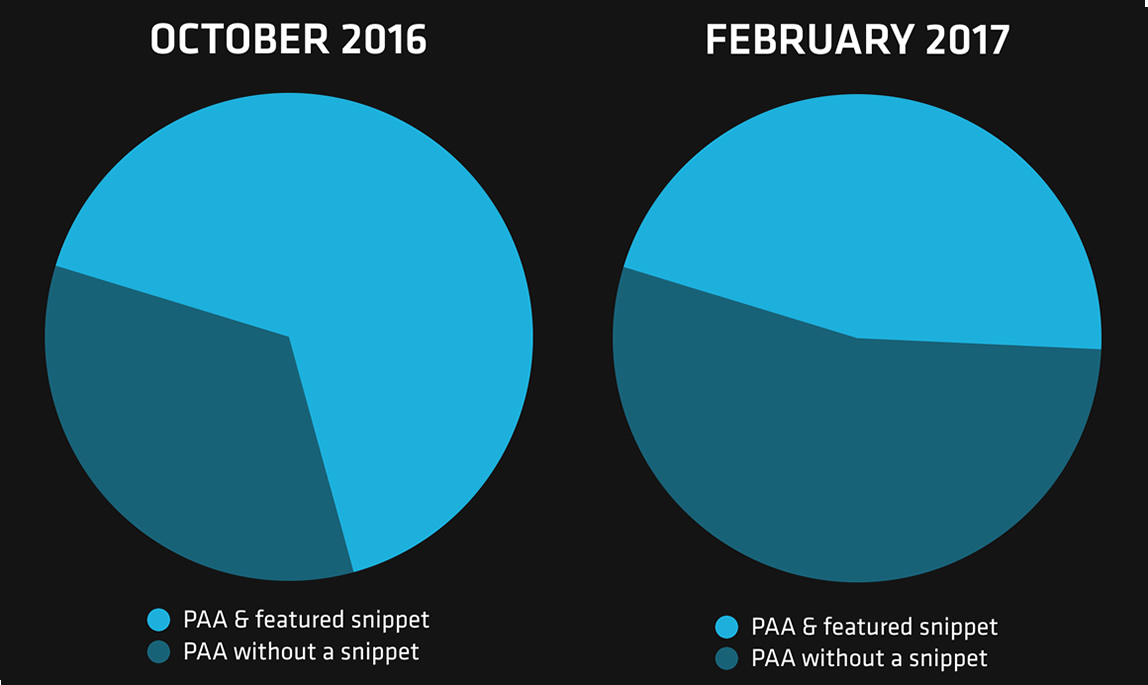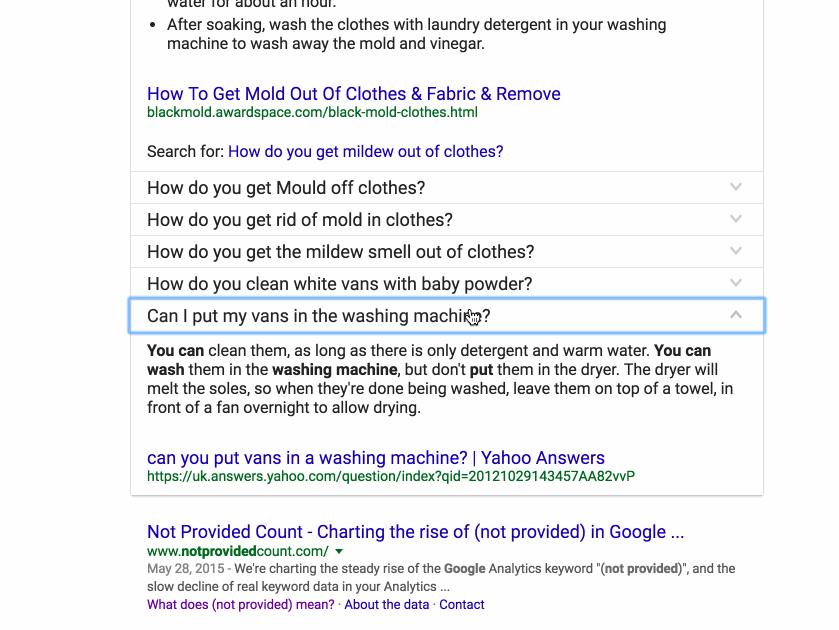We hopped back into PAA boxes to see how things have changed over the past five months.
A while back we dug deep into “People also ask” boxes to see what they were hiding. Since the SERPs never sleep, we did it all over again to see if they’ve got any new surprises.
Back in October 2016, we compiled a list of 894 keywords, loaded them into STAT, and tracked them on mobile and desktop SERPs in Bee Cave, Texas — giving us 1,788 keywords to explore.
Among our initial results, we found gems like:
- PAAs appeared on 20 percent of our SERPs.
- PAAs show up equally on desktop and mobile.
- The same PAA questions often appear for different keywords.
- PAAs almost always pair the same answer with the same question.
Five months later we launched a new PAA report that automatically grabs the data we’d previously gathered manually. This made it easy-peasy lemon squeezy for us to refresh our research, so we threw our 1,788 keywords back into STAT and got analysing.
PAAs ARE ON THE RISE
In October, we saw that 20 percent of our 1,788 keywords returned a PAA. When we looked again in February 2017, we saw that PAA boxes now appear for 32 percent of them, which means PAAs made an overall increase of 57 percent.
Moving on up!
We’re seeing a 57% increase in PAAs over the past five months.
Not only has the number of PAA boxes appearing on SERPs increased, but the number of questions appearing in each PAA box has also risen. On average, three questions appeared in a PAA box back in October; today, that’s sitting at four.
And yes, we’ll address that pesky “infinite” PAA a little later in this post.
PAAs still prefer desktop (if only by a hair)
Even though we’re moving into a mobile-first SERP world, there’s still a fairly even split of PAAs between desktop and mobile devices.
Swipe for more →
| Oct ’16 | Feb ’17 | |
| Desktop PAAs | 183 | 291 |
| Mobile PAAs | 181 | 282 |
| Total PAAs | 364 | 574 |
Desktop vs. mobile
“People also ask” results don’t have a strong preference for either device type.
Looking at this chart, you can see that desktop is still eking out the smallest of wins over mobile. As for how PAA content differs between desktop and mobile — we’ll dig into that a little further down.
More PAAs, less featured snippets
We were surprised to see that the relationship between “People also ask” boxes and featured snippets had weakened over time. In October, featured snippets appeared on 66 percent of our SERPs with a PAA. In our February data refresh, featured snippets were down to sharing SERP space with a PAA only 46 percent of the time.
Do PAAs appear alongside featured snippets?
Yes, but not nearly as often as they did five months ago.
Since PAAs and featured snippets have many of the same qualities — we’ve even gone so far as to call them cousins — this dip could be Google testing to see if more people will explore the nooks and crannies of a PAA than a featured snippet. And this got us wondering, could snippets find themselves dethroned by PAAs in the near future?
Earning a single PAA still pays off multiple times
If you remember from our original research, the same questions often appear in PAA boxes for different yet related search queries — ie. the PAA question “Is Avocado good for losing weight” shows up for both [foods that are good for you] and [top healthy foods to eat] queries.
In February, our 291 desktop PAAs produced 1,159 questions in total — 404 (35 percent) were unique and 755 (65 percent) were repeats. Compared with October, where 41 percent were unique and 59 percent were duplicates, it appears that the more questions there are, the more they repeat themselves.
Swipe for more →
| Oct ’16 | Feb ’17 | |
| Desktop PAAs | 183 | 291 |
| Total questions | 615 | 1,159 |
| Total unique questions | 255 (41%) | 404 (35%) |
| Total duplicate questions | 360 (59%) | 755 (65%) |
Lots of repeated questions
“People also ask” boxes will return a lot of duplicate questions for a set of related keywords.
(As a point of interest, since not every PAA question shows up more than once, we decided to investigate just how many do. In our February data set, we discovered that a group of 125 unique PAA questions appeared the 755 times for our keywords.)
Examining the relationship between duplicate PAA questions and their URL answers, we found that the same URL appeared for a duplicate question 96 percent of the time. For example, “How much does Walmart charge to deliver groceries” appeared in a PAA box 65 times, and always pointed to this same URL in the answer.
So, just as we saw in our initial research, snagging a spot in one PAA can result in multiple SERPs-worth of exposure.
The more PAAs change, the more they stay the same
Back in October, we were curious to know how stable a PAA might be. To figure that out, we compared the PAA box produced from a second search, to that of a first, for a set of 50 keywords.
Here’s what we saw:
- 14 PAA boxes from our second search shared one question with the first PAA box;
- 21 boxes shared two questions;
- 8 boxes shared three questions;
- none shared all four;
- 6 had completely new questions;
and one keyword didn’t return a PAA box to compare.
Two "People also ask" boxes for the same query show only one shared question
When we compare the PAA questions from our first search to a second, we see a lot of fluctuation.
Five months later, we wanted to see how much the PAA boxes for those 50 keywords have changed, if at all. Essentially, is the “People also ask” box for a keyword more likely to produce new questions as time passes?
The short answer is: no.
The slightly longer answer is: look at this chart comparing February’s PAA boxes to both October searches.
Swipe for more →
| Feb vs. Oct search 1 | Feb vs. Oct search 2 | |
| Total PAA boxes produced | 44 | 44 |
| Share 1 question | 26 | 23 |
| Share 2 questions | 11 | 12 |
| Share 3 questions | 0 | 5 |
| Share 4 questions | 0 | 0 |
| Share no questions | 7 | 4 |
PAA boxes don’t change too drastically
Five months later, our “People also ask” boxes look relatively the same.
As you can see, the February PAA boxes still have a lot in common with both of their October boxes — the majority share one or two questions with their previous PAA.
If we strip out the PAA questions from each box, from each of our three searches, we can see just how repetitive PAA boxes are in a given grouped keywords set.
Our first 50 keyword search produced 50 PAA boxes with 195 questions, our second produced 49 PAAs, with 179 questions, and our third produced 44 PAAs with 176 questions. Altogether, we’re looking at 550 PAA questions.
But how many of those are unique?
Just 193 (35 percent) — that’s roughly 16 new boxes each time we performed the search. After your initial PAA research, this makes keeping track of new PAA questions to optimize for totally doable.
Infinite PAAs are large and in charge
We mentioned above that if you search a bunch of similar terms, you’ll see a lot of the same PAA questions appear. But there’s another kind of repetitive PAA to look out for, one with seemingly infinite questions.
In our last post, we mentioned the presence of an infinite PAA: a “People also ask” box that generates a new question each time you click an existing one. At the time, there was great debate as to whether it was just a bug or a permanent feature, but as of mid-February, they’ve officially launched in the US.
Since infinite PAAs have been following Moz’s Britney Muller around the internet like a targeted ad, she dove head-first into the rabbit hole and came back with some crazy-deep insights. Read up on her infinite research here.
An infinite PAA in action
This is the PAA that never ends, yes it goes on and on my friends. Courtesy of Britney Muller.
Infinite PAAs are dynamic and change according to a user’s search patterns, which makes capturing each question in them seem like trying to document the shape of every single snowflake, so what does mean for our new PAA report?
If you’ll recall from our last piece and Britney’s latest research, even infinite PAAs start repeating questions. This means that even by tracking and analyzing the questions and URLs that you can see in a PAA box before you get click-happy, you can surface most questions, uncover loads of content ideas, help your keyword research along, and gain a better understanding of your competition.
What we’ve learned by doing this refresh
While not earth-shattering (yet), PAAs have evolved in the following ways:
- PAAs are booming, with an increase of 57 percent over the past five months.
- PAAs still appear almost equally on desktop and mobile devices.
- We’re spotting some device-specific PAAs, so it’s important to track on both desktop and mobile.
- PAAs continue to dish out multiple SERPs-worth of exposure for the lucky ducks that happen to snag them.
- Infinite PAAs are stickin’ around — we’ve even started seeing them on mobile and desktop devices here in Canada, eh?
As always, we’re continuing to track how this result type changes over time, so we’ll keep you posted if we see anything new.
In the meantime, if you’d like to see the different ways to track them for yourself in STAT, give us a holler at ClientSuccess@getSTAT.com.






